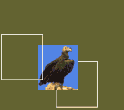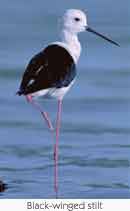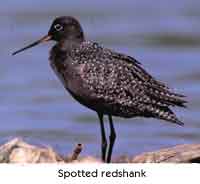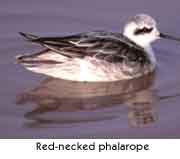

INTERESTED IN PRINTED T-SHIRTS?

|

WANT TO SEND AN ECARD?

|

|
|
 By Hanne and Jens Eriksen By Hanne and Jens Eriksen
(authors' unabridged text)
What's so special and wonderful about waders, you may ask? Ornithologists all over are looking at this group of birds with great enthusiasm and excitement. It consists of 214 species world-wide subdivided into 12 families. Nine of these families and more than 60 species appear in Arabia. Most species are great migrants travelling over huge distances and waders are found practically in every corner of the globe. Being such great travellers make them potential vagrants outside their normal distribution. Identification of waders can be a big challenge; superficially, many waders look similar and one often has to look for small details to make a positive identification which requires a high degree of accuracy and lots of field experience on the part of the observer. Beginners may despair, but the reward of slowly, species by species, getting to grips with the various waders soon makes up for the initial trouble. Generally, males and females look the same, but immature and adult birds often look quite different. In addition, there are spectacular differences in the plumage of many species in winter and summer. All this adds to the confusion, but also the challenge, of wader identification. They remain one of the most popular groups of birds among birdwatchers and you never know when yet another American species may turn up on your local patch.
The first step in identifying a wader is to recognise the family to which it belongs. Once you get a good feeling for the families it is easier to determine each species. Beginners and advanced birders all need the help from good field guides and today most regions of the world are covered. One particular book that includes all of the world’s waders must be mentioned, namely 'Shorebirds: An identification guide to the waders of the world' by P. Hayman, J. Marchant and T. Prater, Croom Helm, London 1986.
Jacanas
Eight species world-wide. Jacanas are small to medium sized birds characterised by having extremely long toes and claws that distribute their weight in such a way that they can walk on floating vegetation. Jacanas are popularly called lily-trotters as they are often seen walking over lily pads. The pheasant-tailed jacana (Hydrophasianus chirurgus) is the largest of them all and the only one to be seen in Arabia, where it can be found primarily in the south of Oman. Its movements are not fully understood. It is a bird common to India and the bird fauna of northern Oman is in many ways similar to that of India. Contrary to expectation, the pheasant-tailed jacana is rarely seen in the north but is found every year around Salalah in the southern part of the country. In fact, it is seen here in most months of the year, but only a few birds stay during the summer months.
Painted Snipes
This family consists of only two species, one in South America and the painted snipe (Rostratula benghalensis) found on the marshlands of Africa, Asia and Australia. Despite being common in places in both East Africa and India, the Painted Snipe is only rarely seen in Arabia.
Crab Plover
The crab plover (Dromas ardeola) forms a family of its own. Furthermore it has a limited range consisting of the shores of East Africa, Arabia, Iran and Western India.
It has long, pale blue legs, a distinct black and white plumage and a heavy black beak adapted to opening crab shells to get to their favourite food. Crab plovers are gregarious at all times; they feed in flocks, migrate in flocks and are colonial breeders. Food is found on mudflats, sandy beaches and in khors. Amongst waders, they are unique in the way that they breed in burrows dug out in the sand. An egg chamber at the end holds a single egg. Good places to see crab plovers are in the UAE and Oman.

Oystercatchers
A family of 11 species spread out over most parts of the world. They are medium sized birds stoutly built with relatively short legs and a heavy dagger-like beak. Beaks, eyes and legs are always colourful ranging from red to yellow and the plumage distinct in black, brown and white or any combination thereof. Most oystercatchers are coastal breeders equally at home on rocky shores and sandy beaches.
The oystercatcher (Haematopus ostralegus) is the only one to appear in Arabia, where it is a locally common migrant and winter visitor. A few stay over the summer.
Stilts and Avocets
Seven species belong to this family, all slim, medium sized birds that live in wetlands in hot and warm climates. There are three species of stilts, so named because of their extremely long legs, and four species of avocet that are characterised by their strongly up-curved beaks. Avocets feed by making energetic sideways sweeps through the water, during which action small food particles are caught in lamellae in the beak. Stilts have straight, long beaks and when feeding you see them jabbing their beaks quickly into the water to grip their food. The plumage of stilts and avocets is black and white with two species of avocets also having a reddish colour on their heads.
Black-winged stilts (Himantopus himantopus) are present all year round in Arabia. They breed in small numbers singly or in loose colonies. They are also a common migrant and winter visitor that may be seen at inland lakes, khors, along the coast or at sewage ponds.
The avocet (Recurvirostra avosetta) is a regular migrant and winter visitor to Arabia albeit in small numbers. In recent years some birds have bred in the UAE. Other breeding sites are known to exist along the shores of the Arabian Gulf.
Thick-knees
Nine species world-wide. The name refers to what on the bird resembles a swollen knee, although it is actually the ankle joint one is looking at. Thick-knees are active night birds that spend most of the day resting. They are characterised by a big head, large eyes, a stout beak and a cryptic plumage.
In Arabia, the stone curlew (Burhinus oedicnemus) is a regular winter visitor. The spotted thick-knee (Burhinus capensis) is a widespread, though thinly distributed, resident breeder in Oman and Yemen. A third species, the great stone plover (Esacus recurvirostris) has been recorded regularly in northern Oman, but surprisingly, not yet in the UAE.
The families mentioned so far are all very distinctive and identification of individual species should not cause too much trouble. From now on it gets more difficult, though!
 Coursers and Pratincoles Coursers and Pratincoles
Nine coursers and eight pratincoles are found world-wide. Coursers are small to middle sized, elegant and delicately looking birds of dry habitats. Pratincoles are short-legged and long-winged waders that resembles swallows or terns in their buoyant flight. They feed on insects caught in the air.
In Arabia you may see the cream-coloured courser (Cursorius cursor) all year round. The collared pratincole, Glareola pratincola, is a passage migrant in general, but a breeding visitor to Oman and Saudi Arabia with single, small colonies in both countries. The breeding colony near Sohar on the Batinah in Oman was discovered just a few years ago. Breeding occurs in May/June. Are there other colonies to be found, we wonder? Black-winged pratincole (Glareola nordmanni) and oriental pratincole (Glareola maldivarum) are very similar to the collared pratincole and great skill is needed to separate them conclusively. These two and the little pratincole (Glareola lactea) are rare but have all been recorded in the area.
Plovers
With 67 species world-wide this constitutes a very large group of birds that come in two sizes corresponding to two subfamilies, the larger birds being the 25 lapwings and the smaller the 41 plovers. The additional one bird in the plover family is the Magellanic plover that has its own subfamily. Plovers have a characteristic feeding technique hunting for invertebrates on or in the ground. They make repeated runs, interrupted by a standstill, when they may or may not catch a food item before they make the next run.
In Arabia about 15 species are found; some of which are breeding birds, the majority passage migrants and/or winter visitors. To name a few, the red-wattled plover (Hoplopterus indicus) is a breeding resident in northern Oman and the UAE while the white-tailed plover (Chettusia leucura) has bred recently in the UAE and Saudi Arabia, and the spur-winged plover (Hoplopterus spinosus) is breeding along the Red Sea. Kentish plovers (Charadrius alexandrinus) are widespread resident breeders along the coast and sometimes this species may be found far away from the sea at inland rainwater pools. The little ringed plover (Charadrius dubius) is a common winter visitor and some stay to breed in spring. The sociable plover (Chettusia gregaria) is a scarce winter visitor and much sought after by visiting birdwatchers. Huge flocks of lesser (Charadrius mongolus) and greater sand plovers (Charadrius leschenaultii) wintering along the shores of Arabia and they can be quite difficult to separate in the field.
 Snipes, Sandpipers and Phalaropes Snipes, Sandpipers and Phalaropes
Being the biggest family of the waders, 86 species are represented in six subfamilies. In a way they seem to be the true waders as the majority spend a good part of their lives wading through shallow water in search of food. Size, colour and general appearance vary significantly, as do the size and shape of the beaks. Often many species feed together, for example at exposed mudflats at low tide. Do they compete for exactly the same food? Not necessarily! The difference in beak forms enable each species to obtain its food in a slightly different way to another species, so whatever the shape of the beak, it is highly adapted to extract exactly the food that that species needs. Also, some species will feed around small pebbles, others around vegetation and yet again others in sandy areas or on open mudflats.
Well over 30 species occur in Arabia, primarily as passage migrants and winter visitors along the coasts. It is these species, especially the smaller sandpipers and stints, which cause the greatest challenge in identification. They include familiar species like the curlew (Numenius arquata), redshank (Tringa totanus) and Dunlin (Calidris alpina) and rarities such as Great Knot (Calidris tenuirostris), Terek sandpiper (Xenus cinereus) and broad-billed sandpiper (Limicola falcinellus).
Phalaropes are delightful little birds breeding in the high Arctic. The red-necked phalarope (Phalaropus lobatus) is by far the most common species in our area and the Arabian Sea is the main wintering area for this species. Thousands of birds may be seen and one birdwatcher on a tanker estimated seeing over 100,000 red-necked phalaropes in one day.
Arabian shores are well known for their richness both in numbers of waders and in species diversity. Mudflats in Bahrain, at Khor Dubai and Khor Al Beidah in Umm Al Quwain are attracting foreign birdwatchers in increasing numbers. No area, however, can match Barr Al Hikman in Oman, which is recognised as being of international importance as the wintering grounds for waders. See the Barr Al Kikman article in this issue for a closer look at this special area.
All material on this page is copyrighted by Trident Press Ltd and/or individual contributors.
Unauthorised use of photographs or text is strictly prohibited.
|
|
|





 By Hanne and Jens Eriksen
By Hanne and Jens Eriksen
 Coursers and Pratincoles
Coursers and Pratincoles Snipes, Sandpipers and Phalaropes
Snipes, Sandpipers and Phalaropes